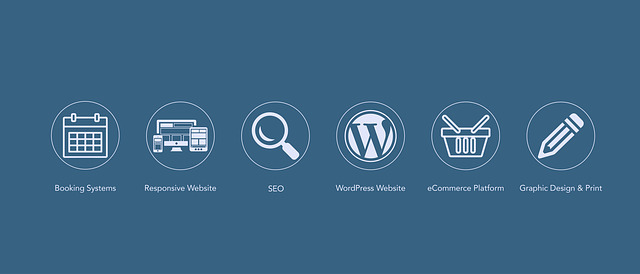Implementing Schema for Medical Services significantly boosts online visibility for healthcare providers, especially dentists and therapists. By using structured data formats, these businesses enhance local search results with rich information about services, qualifications, and patient reviews. This strategy improves SEO rankings, attracts qualified leads, and increases patient trust. A strategic process involves identifying service types, selecting relevant schema markup from Structured Data for Services, integrating it into website HTML, and testing implementation to ensure accurate interpretation by search engines. Best practices include detailing treatments, procedures, and healthcare plans, along with medical professionals' qualifications. Measuring success through key metrics helps gauge the impact on patient engagement and conversions. Staying current with schema markup trends ensures medical practices stand out in a competitive market and foster trust among prospective clients.
In the digital age, enhancing the visibility and context of medical services is paramount. Schema markup, a structured data format, plays a pivotal role in Search Engine Optimization (SEO) for healthcare content. This article delves into the transformative power of schema for medical practices, detailing its impact on search engine results pages (SERPs). We provide a comprehensive guide to implementation, best practices, and measurement strategies, enabling healthcare businesses to stay ahead in a competitive market through effective schema utilization.
- Understanding Schema Markup and Its Role in Search Engine Optimization (SEO) for Medical Services
- The Impact of Schema on Search Engine Results Pages (SERPs): Enhanced Visibility for Medical Practices
- Implementing Schema for Different Types of Medical Services: A Step-by-Step Guide
- Best Practices for Writing Accurate and Consistent Schema Markup for Healthcare Businesses
- Measuring Success: Tracking the Effects of Schema Implementation on Patient Engagement and Conversions
- Future Trends in Schema Markup for Medical Content: Staying Ahead in a Competitive Market
Understanding Schema Markup and Its Role in Search Engine Optimization (SEO) for Medical Services

Schema Markup, a structured data format, plays a pivotal role in enhancing visibility and context for medical services in search engine results. By implementing Schema for Medical Services, businesses can provide search engines with detailed information about their offerings, improving the accuracy of local search results and driving more relevant traffic. This is particularly beneficial for medical practices, as it enables them to highlight specific services, healthcare qualifications, and patient testimonials, all of which are crucial for building trust with prospective patients.
The Local Schema for Providers, a subset of Schema Markup, allows businesses to signal their physical location and service areas, enabling search engines to understand the geographical context better. Structured Data for Services goes beyond basic information by offering a comprehensive framework to describe unique selling points, pricing structures, and patient-centric benefits. This level of detail not only boosts SEO but also enriches the user experience, encouraging potential patients to choose the business among competitors.
The Impact of Schema on Search Engine Results Pages (SERPs): Enhanced Visibility for Medical Practices

Implementing schema markup for medical services can significantly impact search engine results pages (SERPs), offering enhanced visibility and improved context to potential patients. When properly structured, schema data allows search engines to understand the unique offerings and nuances of medical practices, resulting in more accurate and relevant search results. This is particularly beneficial for local businesses, as it enables them to showcase their specialized services and reach their target audience more effectively.
For instance, using local schema markup for providers can help patients searching for specific therapists or healthcare professionals in their area. Schema markup for business types, such as medical clinics or specialized practices, provides search engines with detailed information about the services offered, ensuring that these businesses appear in SERPs tailored to users’ queries. By utilizing schema, medical practices can increase their online presence and attract more qualified leads, ultimately improving patient acquisition and satisfaction.
Implementing Schema for Different Types of Medical Services: A Step-by-Step Guide

Implementing schema for medical services is a strategic move to boost online visibility and accessibility. This process structures data within your content, making it more understandable for search engines like Google. When it comes to different types of medical services, here’s a step-by-step guide tailored for dentists and therapists:
1. Identify Service Types: Start by clearly defining the specific services offered. For dentists, this could be cosmetic dentistry, orthodontics, or dental implants. Therapists might offer counseling, psychotherapy, or art therapy. Each service type should have its own unique structured data.
2. Choose Relevant Schema Markup: Depending on your offerings, select appropriate schema types from the Structured Data for Services vocabulary. For instance, use `MedicalSpecialty` to define dental specialties, and `Therapy` for therapeutic practices. Ensure these are accurately described using the provided properties, covering details like service name, description, and eligibility criteria.
3. Implement Markup on Website: Integrate the chosen schema into your website’s HTML code. This involves adding specific tags and attributes to relevant content sections. For a dentist’s site, this could mean markup for doctor profiles, service pages, and appointment-related information. Therapists can utilize schema for client testimonials, treatment details, and session booking systems.
4. Test and Verify: Utilize tools like Google’s Structured Data Testing Tool to validate your schema implementation. Ensure search engines can accurately interpret the structured data by checking for any errors or warnings. Regular testing is crucial as schema markup evolves with updates from schema developers.
Best Practices for Writing Accurate and Consistent Schema Markup for Healthcare Businesses

Implementing accurate and consistent schema markup is essential for healthcare businesses to enhance their online visibility and provide rich snippets in search results. When it comes to structuring data for medical services, a well-planned schema can significantly improve patient engagement and trust. Best practices include ensuring that all service-related information is up-to-date and accurately represented using the appropriate Schema for Medical Services vocabulary. This includes detailing specific treatments, procedures, and healthcare plans offered, along with relevant qualifications and specialties of medical professionals.
For instance, a local dentist’s website can leverage Local Schema for Providers to showcase their location, business hours, contact details, and available services. Structured Data for Services should be used to describe each dental procedure, highlighting benefits, risks, and typical costs. By adhering to these best practices, healthcare providers can create a seamless and informative experience for potential patients, ultimately driving better search engine rankings and increased website traffic.
Measuring Success: Tracking the Effects of Schema Implementation on Patient Engagement and Conversions

Measuring success is a vital step after implementing schema to enhance content visibility and context, especially in the medical services landscape. By tracking key metrics, providers can understand the impact on patient engagement and conversions. One effective approach is to monitor website analytics to see if structured data for services has increased organic traffic from search engines, indicating improved online visibility.
Additionally, examining conversion rates before and after schema integration can provide insights into its effectiveness. For instance, tracking the number of patients scheduling appointments or requesting information through optimized service pages reveals direct correlations between schema implementation and patient engagement. The local schema for providers can also be evaluated by analyzing patient demographics and geographic locations to understand how it has influenced local reach and conversions.
Future Trends in Schema Markup for Medical Content: Staying Ahead in a Competitive Market

As technology evolves, so do the expectations of online users seeking medical information and services. Future trends in schema markup for medical content aim to stay ahead of this competitive market by providing more accurate and detailed structured data for services. By implementing advanced Schema for Therapists and Dentists (and other specialized fields), content creators can ensure search engines understand the nuances of their offerings, leading to better visibility and patient outcomes.
This shift towards enhanced context is driven by the need to compete in a crowded digital landscape. Using schema markup effectively allows medical practices to stand out, making their content more appealing to both search algorithms and potential patients. For instance, structured data for services can include specific treatments, qualifications, and availability, enabling efficient navigation and personalizing patient experiences. By staying updated with these trends, medical professionals can ensure their online presence not only attracts but also educates prospective clients, fostering trust and loyalty in a highly competitive market.
